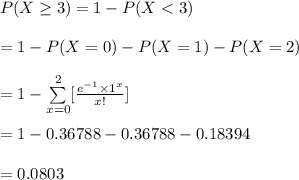
Mathematics, 12.10.2020 01:01 xXCoryxKenshinXx
Astronomers treat the number of stars X in a given volume of space as Poisson random variable. The density of stars in the Milky Way Galaxy in the vicinity of our solar system is one star per 16 cubic light-years, on average. NOTE: Light-years is a distance measure. 7. What is the probability of exactly two stars in 16 cubic light-years? 8. What is the probability of three or more stars in 16 cubic light-years? 9. How many stars would be expected in 4 cubic light years? 10. How many stars would be expected in t cubic light years? 11. How many cubic light-years of space must be studied so that the probability of one or more stars exceeds 0.95? HINT: let `t' represent the unknown region of space, then nd the `t' that gives you the relevant probability.

Answers: 2


Other questions on the subject: Mathematics



Mathematics, 21.06.2019 16:00, pringleosmond
65 8 7 4 5 6 8 4 3 2 1 9 5 6 4 2 1 6 5 1 5 1 3 2 3 5 multiply the third number in the first row by the seventh number in the third row. add this result to the fifth number in the second row. add to this total ten times the fourth number in the third row. subtract the eighth number in the first row from the result.
Answers: 3
You know the right answer?
Astronomers treat the number of stars X in a given volume of space as Poisson random variable. The d...
Questions in other subjects:










Chemistry, 13.12.2019 02:31







